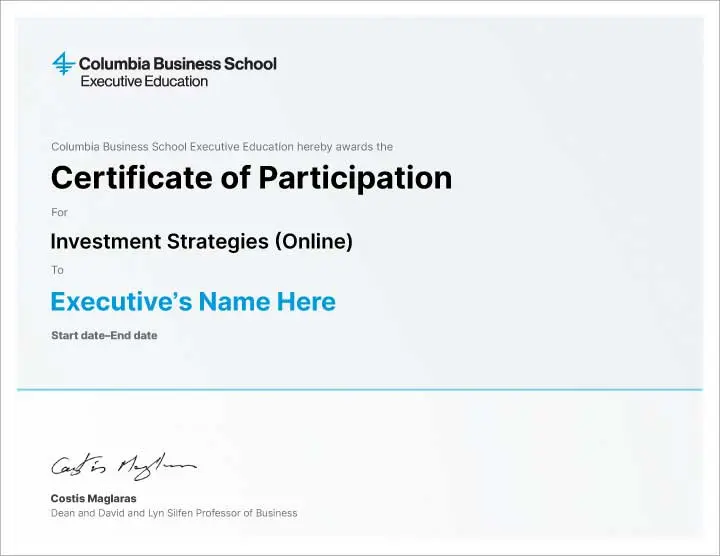
Investment Strategies (Online)
Early Registration Benefit
Apply by Invalid liquid data, to receive an early registration benefit of Invalid liquid data. Connect with a learning advisor for more information.
Advance Your Investing Intelligence
Whether you are a finance professional, a career switcher, or an ambitious investor, success in today’s markets requires more than intuition — it demands rigorous tools and disciplined strategy. For individual and professional investors who want to strengthen their investment decision making, the Investment Strategies (Online) program from Columbia Business School Executive Education builds a rigorous understanding in how markets work — across stocks, bonds, and risk-free assets — and how to apply strategies that improve portfolio performance.
Led by Harry Mamaysky, professor of professional practice and the director of the Program for Financial Studies at Columbia Business School, this program is designed for anyone seeking to transform their approach to portfolio management, from new asset managers to seasoned wealth advisors. Over nine weeks, you will explore how stocks, bonds, and global capital markets interact, learn to measure risk and return, and develop a disciplined approach to diversification.
Through interactive exercises, case studies, and applied assignments using real financial data, you will practice valuation, risk analysis, forecasting, and portfolio construction. By the end, you will understand the behavior of core asset classes and gain the confidence to use professional-grade investment tools in your career or personal portfolio.
Who Is This Program For?
The Investment Strategies (Online) program is designed for executives who want to elevate their market knowledge and apply professional-grade tools to real-world investment decisions. It is especially beneficial for:
Retail investors and high-net-worth individuals like individual investors, active traders, entrepreneurs, small business owners, and family office managers looking to professionalize their approach, apply disciplined strategies, and avoid costly mistakes in managing personal or family wealth
Early-career finance professionals working as finance analysts, associates, consultants in equity research, asset management, risk, and wealth management, banking, or fintech who want to sharpen valuation and portfolio skills while accelerating their careers
Career switchers into finance such as professionals from fields such as accounting, auditing, corporate law, economics, business development or any related profession who want to build a structured foundation and transition into roles in investment management, equity research, or fintech
Global professionals including mid-career practitioners who want to integrate leading global investment strategies into their local practice
What Will You Learn?
The Investment Strategies (Online) program will enable you to:
Better inform your market opinions with a deeper understanding of capital markets, major investable asset classes, the challenges of leveraging and shorting, and how to use financial and economic databases
Avoid common investment pitfalls by gaining an understanding of overleveraging and underappreciating
Make educated stock selections by measuring risk and applying risk management and analytical theory to your choices
Become an active portfolio manager by analyzing the performance of investment products over time, understanding bond market and yield, and knowing the tools for — and limits of — forecasting
Program Modules
Applied Learning Through Focused Assignments
Each module includes assignments that are designed to bridge theory and practice using real data from sources such as FRED, Yahoo Finance, Finviz, and the JST Macrohistory database. You will:
Test valuation models on companies, including Apple, Tesla, and IBM
Measure risk with Sharpe ratios and correlation matrices
Build and evaluate portfolios using diversification techniques
By working hands-on with financial data sets, you will gain the confidence to move from understanding concepts to applying them like a professional. The result is a practical skill set and the confidence to apply professional-grade investing tools to real markets — accelerating careers and sharpening investment decisions.
Program Experience

World-Renowned Faculty
Learn from accomplished faculty, and industry experts whose diverse backgrounds encompass a broad range of disciplines

Peer Interaction
Stimulating discussions with like-minded global peers expand your professional network and build a supportive community

Case Studies
Through exploratory sessions, examine practical examples and find innovative solutions to strategic challenges

15+ Assignments and Activities
Hone business acumen and executive skills with try-it activities that help you redefine your potential
Real-World Applications and Learning Activities
You’ll have access to a range of hands-on tools and activities that bridge the theoretical and the practical to help make you a more effective investor. Some examples include:
Hedge Fund Case Study: Explore the real-world gains and perils that can occur when aggressively using leverage and risk in the investment process.
Measurement Tools: Examine and apply different approaches for measuring investment performance — including risk exposure — using the Sharpe ratio and the information ratio.
Financial Data Resources: Construct and manage a diversified portfolio and learn to use an invaluable set of online resources that can help you create an investment strategy and wisely implement it, such as Yahoo Finance, Finviz, Macrohistory and FRED.
Why This Program?
In just nine weeks, you will sharpen your ability to value securities, assess risk, and construct diversified portfolios — skills you can use immediately in your work or your own investments.
Value stocks and markets with tools, including the dividend discount model, price–earnings (P/E) ratios, and Shiller’s CAPE
Earn a Columbia Business School certificate that builds professional credibility
Participant Testimonials


Program Faculty

Professor of Professional Practice, Director of the Program for Financial Studies, Columbia Business School

Certificate
Upon completion of the Investment Strategies (Online) program, you will receive a certificate of participation from Columbia Business School Executive Education. This certificate also awards two credits towards the Certificate in Business Excellence, which grants select alumni and tuition benefits. Learn More
Your digitally verified certificate will be issued in your legal name and emailed to you, at no additional cost, upon completion of the program, including all modules of the program (online, in person, or live online, inter-module). All certificate images are for illustrative purposes only and may be subject to change at the discretion of Columbia Business School Executive Education.
FAQs
Financing Options
Climb Credit*
We offer financing options with our partner, Climb Credit*. Click here to learn more. *Applicable for US Residents
Flexible Payment Options For All
Flexible payment options allow you to pay the program fee in installments. Click here to see payment schedule.
Didn't find what you were looking for? Write to us at learner.success@emeritus.org or Schedule a call with one of our Program Advisors or call us at +1 315 387 4431 (US) / +44 203 838 0836 (UK) / +65 3138 4449 (SG)
Flexible payment options available.
Starts On

